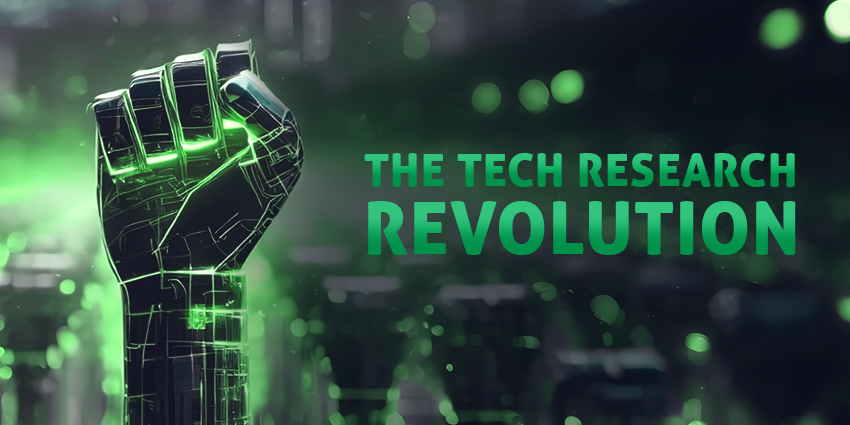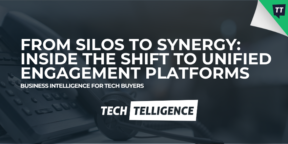Market research has always been tricky. There are a lot of complex factors at play, from choosing the right enterprise sample, to turning raw data into actionable insights. But this process used to be a lot trickier (and more time-consuming). Now we have AI-powered research solutions that streamline the path to revolutionary revelations.
With AI and research automation tools, B2B technology brands can cut through the noise faster, and access the information they really need. In fact, 90% of researchers are regularly using AI in their day-to-day processes (including the team here at Techintelligence).
AI research tools can crunch massive datasets, predict trends before they happen, and uncover buyer intent in ways that human analysts simply can’t – at least, not without weeks of work.
Embracing AI gives companies an opportunity to shift from manual guesswork to automated, efficient, and accurate intelligence. It’s a game-changer, and here’s how you can embrace it.
AI-Powered Tech Research: The Landscape Today
Almost 60% of researchers say their organizations depend on research more today than they did a year ago. This places a lot of pressure on companies to constantly unearth new insights, so they can stay one step ahead of the curve. AI-powered tech research tools help with:
- Buyer Behavior Modeling: By analyzing vast amounts of data, AI can identify patterns in how businesses interact with your products or services. This means understanding not just who your customers are, but how they behave, and why they make decisions. Imagine the impact that has on your marketing and sales efforts.
- Intent Signal Tracking: AI systems can monitor various channels to pick up on intent signals – those subtle hints that a prospect is in the market for what you’re offering. By analyzing behaviors like website visits, content downloads, and social media engagement, AI helps you focus on leads that are more likely to convert.
- Purchase Timing Prediction: Timing is everything. AI can use predictive analysis to detect when a prospect is most likely to make a purchase by analyzing historical data and current behaviors. This allows your sales team to engage at the perfect moment, increasing the chances of closing a deal.
- Opportunity Scoring: Not all leads are created equal. AI assigns scores to prospects based on their likelihood to convert, helping your team prioritize efforts on the most promising opportunities. This means higher efficiency and better conversion rates.
By leveraging AI-powered tech research, B2B brands learn more about customer preferences, help themselves predict future actions, and ensure they focus resources where they’re most likely to pay off. It’s like having a roadmap to your customers’ decision-making processes, leading to smarter strategies and better results. So, where do you begin?
Choosing your AI-Powered Tech Research Tools
Choosing the right AI-powered tech research tools can be tricky, particularly with so many options available in the market. The first step? Identifying what you actually need. Are you looking for research automation tools to simplify data collection, predictive analytics, or buyer intent analysis?
What kind of goals are you trying to accomplish, and what challenges do you need to overcome? Define this clearly before you start searching.
Next, consider how the tools you choose will fit into your existing workflows. Seamless integration is crucial to avoid disruptions. For instance, if you’re conducting research into buyer behaviors, you’ll need a system that integrates with your CRM software. You might also want the system to connect with business intelligence tools, financial reporting apps, and more.
Lastly, think about the potential ROI. While AI tools can be costly, they often lead to significant savings in the long run. Think of all the time and money you could save by reducing the work associated with participant selection, data analysis, and data quality management.
AI-Powered Tech Research: Predictive Analytics Implementation
The B2B tech landscape moves fast. For instance, did you know that 79.3% of CX leaders now trust autonomous virtual agents completely. That’s a huge shift, considering how many companies were reluctant to embrace AI only a couple of years ago.
You can’t really invest in a crystal ball to see the future – but you can use AI-powered tech research to amplify foresight. Predictive analytics helps you refine strategies for:
- Buyer Behavior Modeling: Think of AI as your business’s behavioral analyst. By sifting through mountains of data, AI identifies patterns in how businesses interact with your offerings. This means you can tailor your marketing strategies to resonate with specific behaviors, leading to more personalized and effective campaigns.
- Intent Signal Tracking: Every click, download, or social media mention is a breadcrumb leading to buyer intent. AI excels at following these trails, analyzing behaviors to determine which prospects are actively seeking solutions like yours. By focusing on these high-intent leads, your sales team can engage with prospects who are already in the market for your products or services.
- Purchase Timing Prediction: Timing can make or break a deal. AI analyzes historical data and current behaviors to predict when a prospect is most likely to make a purchase. Engaging with potential buyers at these optimal moments increases the likelihood of closing deals.
- Opportunity Scoring: AI assigns scores to prospects based on their likelihood to convert, helping your team prioritize efforts on the most promising opportunities. This means higher efficiency and better conversion rates.
Invest in predictive analytics, and you’ll have a clearer view of your future in the technology industry – not just present conditions.
Enhancing Insights: Data Quality Automation
Bad data is worse than no data at all. Gartner even found that poor quality data costs businesses around $12.9 million each year. But cleaning and enhancing data manually is time-consuming and complex. So use AI-powered solutions to your advantage.
Experiment with:
- AI Validation Protocols: Forget boring, error-prone manual data checks. Use AI to automate validation processes. By establishing intelligent validation protocols, AI systems can automatically verify data accuracy, consistency, and completeness, reducing errors and enhancing efficiency.
- Intelligent Pattern Recognition: AI excels at identifying patterns within vast datasets. By learning from historical data, AI can recognize expected behaviors and trends, enabling businesses to make informed decisions based on these insights.
- Accurate Anomaly Detection: Spotting anomalies is like finding a needle in a haystack, but AI is your magnet. By continuously monitoring data, AI systems can detect outliers or unusual patterns that may indicate errors or potential issues, allowing for prompt corrective actions.
- AI Quality Scoring Systems: Assigning a quality score to data helps prioritize attention where it’s needed most. AI-driven quality scoring systems, like HubSpot’s Breeze Intelligence, can assess data based on various metrics, providing a clear picture of data health and highlighting areas that require improvement.
AI-Powered Tech Research: Strategic Implementation
Embracing AI for anything, from productivity enhancements to unified communication, and even B2B tech research can be complex at first. So, make sure you have an integration roadmap in place. Identify which processes (data collection, or buyer intent analysis) will benefit most from AI.
Outline the steps needed to incorporate AI into these areas, ensuring alignment with your overall business strategy. Next, think about:
- Team Training Requirements: AI is only as good as the human beings who use it. Your team members need to be equipped to handle new tools effectively. Invest in comprehensive training programs to familiarize them with AI functionalities and applications.
- Success Metrics: How will you know if you’re on the right course? Define clear success metrics. These could include increased efficiency, reduced operational costs, or improved customer satisfaction. For instance, tracking customer satisfaction scores (CSAT) and net promoter scores (NPS) can show the impact of AI on your customer interactions.
- ROI measurement: Data is an investment, and it should be driving positive returns. Measure the return on your AI-powered tech research investment by comparing financial gains against the costs incurred. This includes direct benefits like increased sales and indirect ones like enhanced brand reputation. Explore the true value AI brings.
By carefully charting your integration roadmap, investing in team training, setting clear success metrics, and diligently measuring ROI, you’ll ensure that your voyage into AI-powered tech research ends in fruitful discoveries.
Embracing the AI-Powered Tech Research Era
AI is changing everything, from how we communicate, to our creative processes, and – perhaps most significantly – the way we access and use data. Going forward, evolving AI technologies will only make research processes more efficient and intuitive.
Autonomous systems and agentic AI solutions will empower companies to automate more of the participant selection, validation, and quality scoring process. Enhancements in transparent and ethical AI solutions will ensure we can more consistently trust intelligent insights, and improved integration opportunities will bridge the gaps between disconnected data systems.
Our advice? Stay informed on the latest AI updates and advancements. Keep experimenting, and foster a culture of continuous learning and innovation in your team. Embrace the future of AI-powered tech research, and your business will benefit from deeper, more accurate, and more transformational insights (without the extra headaches).









